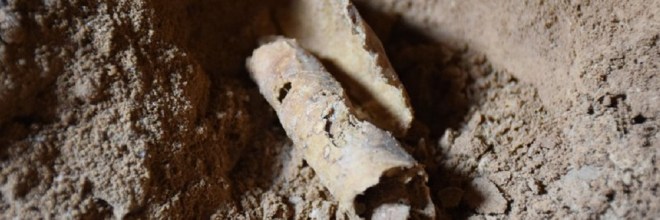Researchers from the Hebrew University of Jerusalem and Virginia’s Liberty University have reportedly discovered fragments of the original Dead Sea Scrolls, ancient texts containing the oldest-known biblical manuscripts, at a new cave located in the West Bank of Israel.
According to Smithsonian.com, Hebrew University archaeologist Oren Gutfeld and his fellow researchers discovered a piece of parchment in a cave hidden in the hills of Wadi Qumran, the same site where 11 caves have previously been found to contain the 2,000-year-old scrolls.
In a statement, Gutfeld emphasizes that no actual Dead Sea Scrolls were found at the new site, but the discovery of the rolled-up parchment “indicate beyond any doubt that the cave contained scrolls that were stolen.” He called the find “one of the most exciting archaeological discoveries, and the most important in the last 60 years, in the caves of Qumran.”
The first fragments of the Dead Sea Scrolls were discovered in the late 1940s by a group of teens exploring a cave at the Wadi Qumran, and as Smithsonian.com explained, the documents are not only ancient records of the Hebrew bible, but also “first-person accounts of history” filled with a “priceless” amount of historical and linguistic information.
Experts have ‘no doubt’ that the cave was once home to a scroll
The excavation which led to the discovery was part of the Israel Antiquities Authority’s (IAA) new “Operation Scroll” initiative, and Gutfield’s team said that they are the first archeologists in more than six decades to discover and properly excavate a new scroll cave at Wadi Qumran.
Their excavation efforts, they explained, revealed that it was indeed home to Dead Sea Scrolls at one time, though as mentioned above, no scrolls were actually found by the research team. What they did find, however, were several jars and lids which dated back to the Second Temple period (530 BC-70 AD), all of which had been broken and had their contents removed.
In addition, the archeologists found two iron pickaxe heads dating back from the 1950s near the back end of the cave, which they say was evidence that the cave had previously been looted. The new cave would not be the first suspected Dead Sea Scrolls location to not actually contain a part of the document, as the eighth cave was also home to scroll jars but no scroll fragments.
“This exciting excavation is the closest we’ve come to discovering new Dead Sea scrolls in 60 years. Until now, it was accepted that Dead Sea scrolls were found only in 11 caves at Qumran, but now there is no doubt that this is the 12th cave,” Gutfield said in a statement.
In addition to the storage jars believed to have held the stolen scrolls, the researchers also found a leather strap that would have been used to bind the parchment, a cloth used to wrap it, pieces of skin-connecting fragments, several flint blades and arrowheads, and a decorated stamp seal made from the semi-precious stone carnelian, indicating that the cave was used during the Chalcolithic and Neolithic periods.
—–
Image credit: Casey L. Olson and Oren Gutfeld





Comments